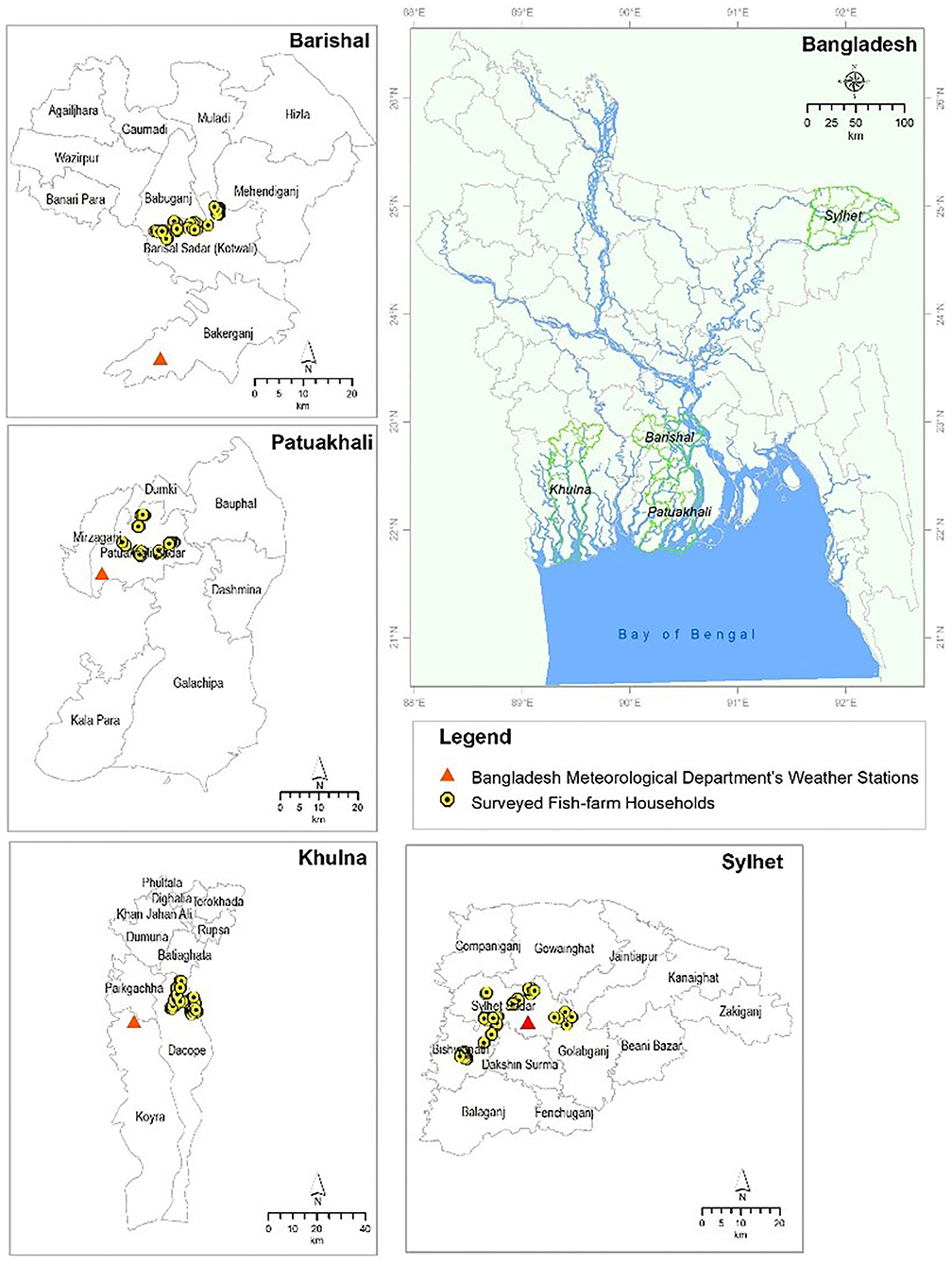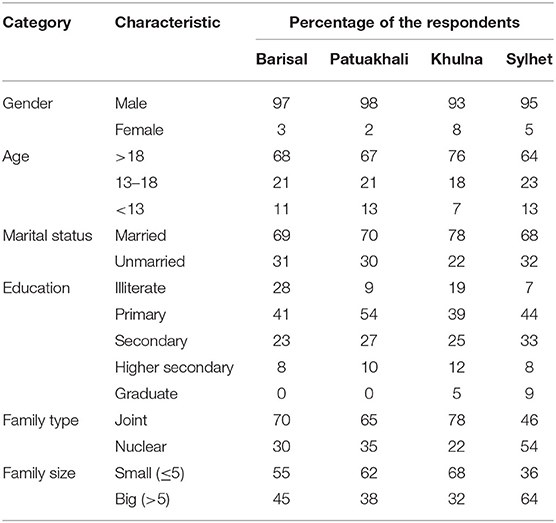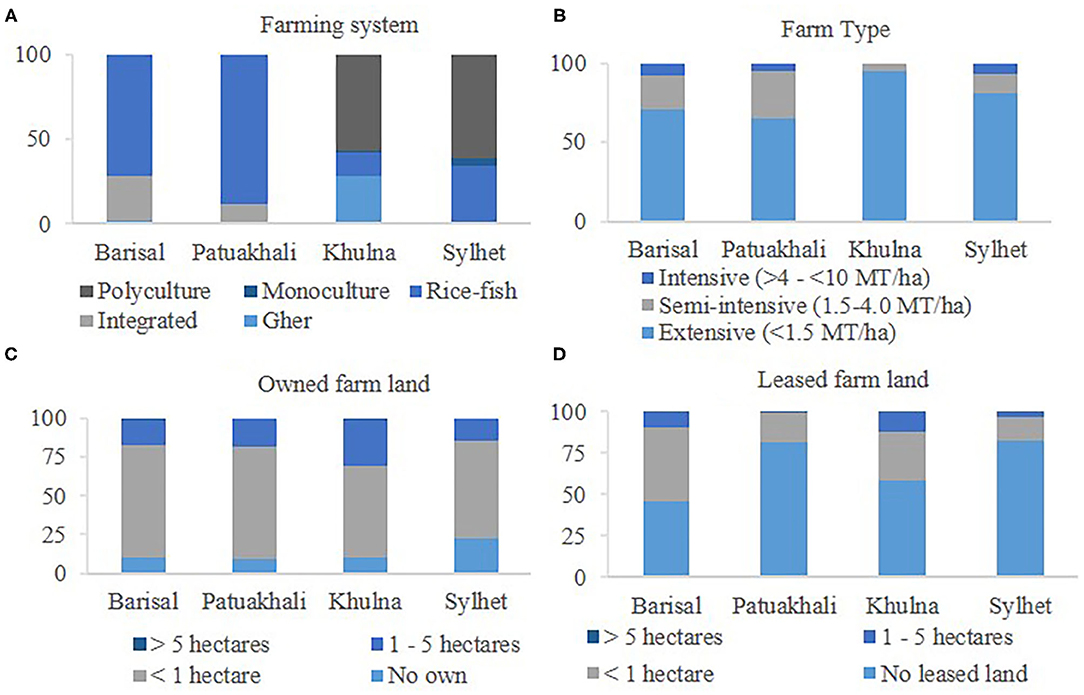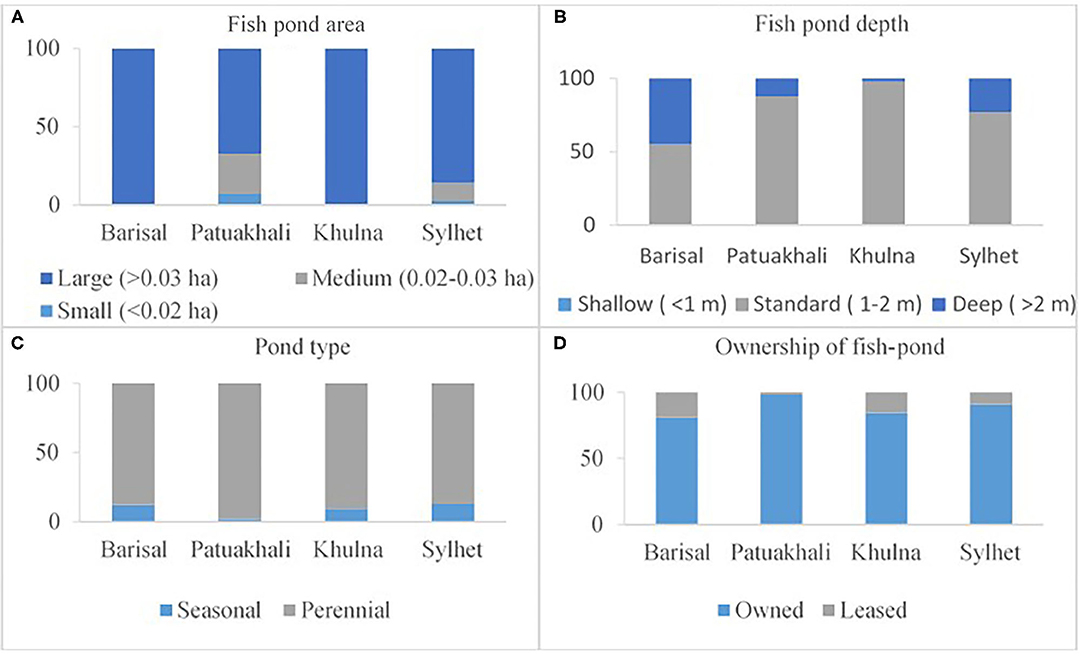- 1WorldFish, Dhaka, Bangladesh
- 2International Maize and Wheat Improvement Center (CIMMYT), Dhaka, Bangladesh
- 3International Research Institute for Climate and Society, Columbia University, New York, NY, United States
- 4WorldFish, Penang, Malaysia
Climate information services (CIS) are increasingly in demand to assist farmers in managing risks associated with climate variability and extremes experienced in food production. However, there are significant gaps in the availability and accessibility of these services, especially in aquatic food production in developing countries. In response, this study aims to generate the background knowledge for developing climate information and decision support services tailored for aquaculture farmers in Bangladesh. We surveyed 800 fish-farming households, interviewed 30 key informants, and conducted a systematic literature review to identify climate-sensitive operations and management decisions in aquaculture and to document fish-farmers' awareness of the relationships between climate variability and aquatic food production systems. We also sought to identify the lead time and communication method(s) needed to deploy forecasts effectively and prepare aquaculture farmers to act in response to the forecasts. A fish-farming activity calendar was developed that identified high temperature, cold spell, heavy rainfall, and dry spell events as key climatic phenomena affecting year-round aquaculture operations, including pond preparation and maintenance, fingerling stocking, grow-out management, and harvesting. We also identified five climate-sensitive management decision points and 26 potential advisories in line with specific climate variability to manage induced risks in the day-to-day operations of fish farmers. Finally, the research team developed a decision framework based on the temperature and rainfall thresholds for the grow-out phase of four widely cultivated and economically important fish species in Bangladesh. This innovative decision support approach is to our knowledge the very first endeavor to develop CIS using species-specific temperature and rainfall thresholds to reduce climate risks and ensure resilience capacity for South Asian aquaculture system.
Introduction
Bangladesh is one of the most suitable countries for aquatic food production in the world, given its large inland freshwater (45,000 km2) and marine water bodies (Ghose, 2014; Shamsuzzaman et al., 2017). It is ranked 3rd in inland fisheries, 5th in aquaculture, and 11th in marine fish production globally (Sarder, 2020). The prominence of aquatic food in the country is reflected in the diet (accounting for 60% of animal protein intake), livelihood opportunities (employing more than 10% of the country's population through fishing, aquaculture, handling, and processing), and economy (contributing about 5% to the country's GDP) (Belton et al., 2014; Bogard et al., 2015; BFTI, 2016; MoF, 2020). However, the sustainability of aquaculture and capture fisheries is increasingly challenged by climatic stresses. The country has been identified as the second most climatically vulnerable country in Asia for freshwater aquaculture and is marked as having the lowest adaptive capacity for brackish water production due to an expected increase in climate variability and frequency of extreme weather events due to global climate change (Barange et al., 2018). These climate stresses impact aquatic food production in multiple ways, such as high water temperatures exceeding the physiological tolerance level of fish species, sudden temperature fluctuations leading to fish mortality, and erratic or intense rainfall events causing harvest losses, which are among the challenges facing aquatic food production systems.
Bangladesh's monthly maximum temperatures remain generally higher (>34°C) in April, May, and June, while monthly minimum temperatures are lower (<20°C) in December, January, and February (Khatun et al., 2016). Besides, the number of extreme hot days, i.e., maximum temperature of >40°C, occurs during April and May. The number of days with maximum temperature ranging from 30 to 36°C per year varies between 109 and 175 days in different parts of the country. Conversely, suitable temperature for fish farming in Bangladesh ranges from 26 to 32°C (Roy et al., 2019). In addition to temperature stress, rainfall variability also exerts stress in aquatic food production. An increasing number of dry spells are recorded in February, April, May, August, and November, while extreme rainfall events are increasing in July, September, and October (Khatun et al., 2016; Hossain, 2018). Temperature (both maximum and minimum) and rainfall variability pose significant risks for aquatic farming activities and require modified management decisions to reduce the risks. Approximately 25% of loss and damage occurred in agriculture, fisheries, and aquaculture sector during the period of 2003–2013 in developing countries can be attributed to climate related impacts (Shelton, 2014). In Bangladesh, a single extreme weather event, such as cyclone “SIDR” caused damages worth USD 6.71 million in aquatic food systems by washing away fish, shrimp, and fingerlings and by damaging infrastructure, gears, and equipment (GoB, 2008). Similarly, a single flood event in 2020 caused USD 5 million worth of loss to the fish farms through infrastructural damage and washing away fishes and fingerlings (Saha, 2020). So, it is evident that climate variability and extreme climatic phenomena are significantly affecting the aquatic food production in Bangladesh.
With high-quality climate information and skillful forecasts tailored to the needs of the fisheries or aquaculture sectors, fish farmers could be empowered to adapt and manage stresses (WorldFish, 2020) and, hence, offset the climate impacts. There is a need for a deep understanding of the sensitivity of different aquaculture operations to specific climatic variables to ensure access to appropriate climate information services (CIS) enabling decision-makers to adapt their decisions. Identification of climate-sensitive aquaculture operations and portfolio-adaptive decisions are, therefore, prerequisite to the development of CIS for aquaculture.
Moreover, 194 countries signed the Paris Agreement for Nationally Determined Contributions (NDCs) in 2015 to transform their development trajectories through adaptation and mitigation efforts (Kalikoski et al., 2018). However, the NDC submissions did not specify mechanisms that could be deployed to support the most vulnerable and poor to deal with climate extremes. In particular, fisheries and aquaculture were inadequately considered. In response to these gaps, there is a considerable scope to integrate and mainstream CIS in national plans, policies, and strategies as a mechanism aiding in enhancing climate resilience. Many countries have begun implementing CIS for agriculture to address climatic risks (Dayamba et al., 2018; Vaughan et al., 2019; Cheng et al., 2020) and meet adaptation needs; however, the application of CIS is a newly emerging field in the aquaculture sector (WorldFish, 2020). Given the potential of CIS in offsetting climate risks to a significant extent (Hansen et al., 2019; Vaughan et al., 2019), it can potentially act as a mechanism to increase investments in aquaculture by small farmers.
Considering the extensive aquatic resources of Bangladesh, the climate impacts on aquaculture production, the socioeconomic vulnerability of small-scale fish producers, and the current lack of CIS for aquaculture in Bangladesh, this study aims to develop a timely, reliable, and contextualized decision support framework to assist small-scale fish farmers in managing climate risks. To develop this framework, we analyzed three tiers of information: field surveys, key informant interviews, and a literature review. We investigated aquaculture management information relevant to CIS, fish producers' knowledge on the effects of climate variability on different aquaculture operations, and their perceptions on the use of CIS. We then mapped out climate-sensitive aquaculture operations and management decisions for climatic variables (and their variability) that could benefit small-scale fish farmers. Finally, we identified temperature and rainfall thresholds for four widely cultivated and economically important fish species to formulate advisories for reducing associated risks.
Materials and Methods
As part of the three-step investigative procedure, we first designed an aquaculture survey module (Supplementary Material 1). This module is based on a combination of field level observation (on fish-farming practices, daily management operations, current demand and access to CIS) and desk study to collect a wide range of information from small-scale fish producers (such as demographics, species selection and management information, perceptions of climate impacts on aquaculture, and potential use of CIS). The aquaculture module was deployed in four districts (Figure 1) with aquaculture farming activities of small-scale fish farmers. Three districts (Khulna, Barisal, and Patuakhali) from the south-west coastal region and one district (Sylhet) from the north-east haor region were selected, the latter being a low-elevation, landscape with a saucer-shaped depression that hosts a wetland-based ecosystem. The districts were selected based on their contribution to cultured fish production in Bangladesh and their exposure to climate risks, particularly temperature and rainfall variability. Four upazilas (subdistricts) were selected from the chosen districts, within a 15- to 25-km radius of the Bangladesh Meteorological Department's (BMD) weather observational stations that provided data for this study. In total, 800 small-scale fish-farming households who are directly involved in fish-farming activities have been surveyed using stratified random sampling (Howell et al., 2020) from October 2019 to December 2019, which covered 18 unions (smallest administrative units) of the selected upazilas (Supplementary Material 2).
Next, we interviewed 30 key informants (selected based on their work experience and expertise relevant to climate impacts on aquaculture research and development) from various government and non-government organizations, universities, and research institutes, purposefully to gather information on the key weather scale impacts affecting aquaculture practices and climate-sensitive aquaculture operations. In addition, the aquaculture experts identified management decisions relevant to the identified climate-sensitive aquaculture operations, critical temperature and rainfall thresholds for widely cultured and economically important fish species in the region, and the expected outcomes from aquaculture CIS.
Lastly, we reviewed the available literature using the ISI-Web of Science, Google Scholar, and Google Search. The review focused on scientific validation of growth phase-specific conditions (temperature and rainfall thresholds) and potential adaptive decisions (to offset the impacts of adverse climatic conditions) identified from the interviews with aquaculture farmers and experts in order to develop useful climate advisories for the key economically important species in Bangladesh. Key search terms used were critical temperature, critical temperature thresholds, heat stress, thermal stress, high-temperature thresholds, low-temperature thresholds, cold spell, heavy rain thresholds, dry spell, drought, and low-rain thresholds. We also used the names of the fish species (both local and scientific) as search terms: rohu (Labeo rohita), tilapia (Oreochromis nilotica), black tiger shrimp (Peneaus monodon), and freshwater prawn (Macrobrachium rosenbergii). The resulting articles were first filtered reading the title followed by the abstract. Final scrutinizing considered the grow-out phase and thresholds (Supplementary Material 3), which we used to cross-check with the thresholds identified by the experts during the key informant interviews. As the literature review and key informant interviews produced only qualitative information on rainfall thresholds, like very heavy rain, heavy rain, low rain, or dry spell, we collected quantitative information on rainfall thresholds for heavy, very heavy, and low rain from BMD.
Using a systematic and logical combination of three sets of information (fish producers' response, expert opinion, and the literature review), we developed the aquaculture decision framework considering four widely cultured and economically important fish species sensitive to temperature and rainfall variabilities (Appendix A). The timeline considered for the decision framework is the grow-out phase of the selected fish species identified during the fish-farmer survey, which was also cross-checked during the key informant interviews. Climatic thresholds for the selected fish species were identified from expert opinion and the literature review considering the least standard deviation of the mean thresholds. The decision points were identified considering both the fish-farmers' and key informants' responses on climate-sensitive aquaculture operations for the grow-out phase of the selected species. Finally, the advisories were developed based on the list of climate-sensitive management decisions identified by the fish farmers as well as the key informants in line with specific decision points and climatic variables. Where thresholds were crossed, recommended actions were developed that could be supplied to fish farmers with the goal of reducing climate risks and enhancing the resilience of the small-scale fish farmers.
Results
Demographics of the Fish Farmers and an Overview of Fish-Farming Practices
Almost all fish farmers (>90%) surveyed were male, and 50–70% were literate with primary (8 years) and secondary education (2 years). The family type is mostly joint, and family size tends to be small, except in Sylhet (Table 1). Aquaculture systems are dominated by rice fish in Barisal and Patuakhali and by fish polyculture in Sylhet and Khulna (Figure 2A), typically extensive farming types (<1.5 MT/ha production) across the studied districts (Figure 2B). Production takes place on both owned (Figure 2C) and leased farmland (Figure 2D) and on <1 ha. However, the use of leased farmland is relatively less common than owned. Fishpond area, pond depth, pond type, and ownership within these farming systems do not vary significantly across the districts (Figure 3). Between 67 and 100% of fish farmers have ponds larger than 0.03 ha (Figure 3A), mostly shallow (Figure 3B), perennial (Figure 3C), and owned (Figure 3D). Thirty to 65% of farmers surveyed had more than 10 years of experience in fish production (Figure 4A); however, 63–91% of farmers acknowledged that they had no formal training in aquaculture (Figure 4B).
Farmers' Fish-Crop Selection and Management Information in 2018
Carps (37–46%) and tilapia (38–45%) are the most widely cultured fish species across the study regions followed by freshwater prawn (1–33%) (Figure 5A). The greatest productivity, however, comes from pangasius (Pangasius pangasius) followed by carps and tilapia (Figure 5B). In addition, farmers have identified four key management interventions applied during the study year as well as 14 different climatic and non-climatic factors that influence their management decision-making process (Table 2). The calendar also shows that fish-farming operations usually (76–100%) start in April with pond preparation and end in December with harvesting. Fingerling collection, stocking, and grow-out management activities typically begin in April–May and continue up to September–October. Both climatic (such as the first monsoon/seasonal rain, heavy rain, floods, water quality and availability, high/low temperatures, and drought) and non-climatic factors (such as credit availability, tradition, disease outbreaks, fingerling prices and availability) influence the identified fish-farming operations. However, grow-out management operations, including feeding, fertilization, and pest and disease control, are mainly timed in relation to climatic factors (Table 2).
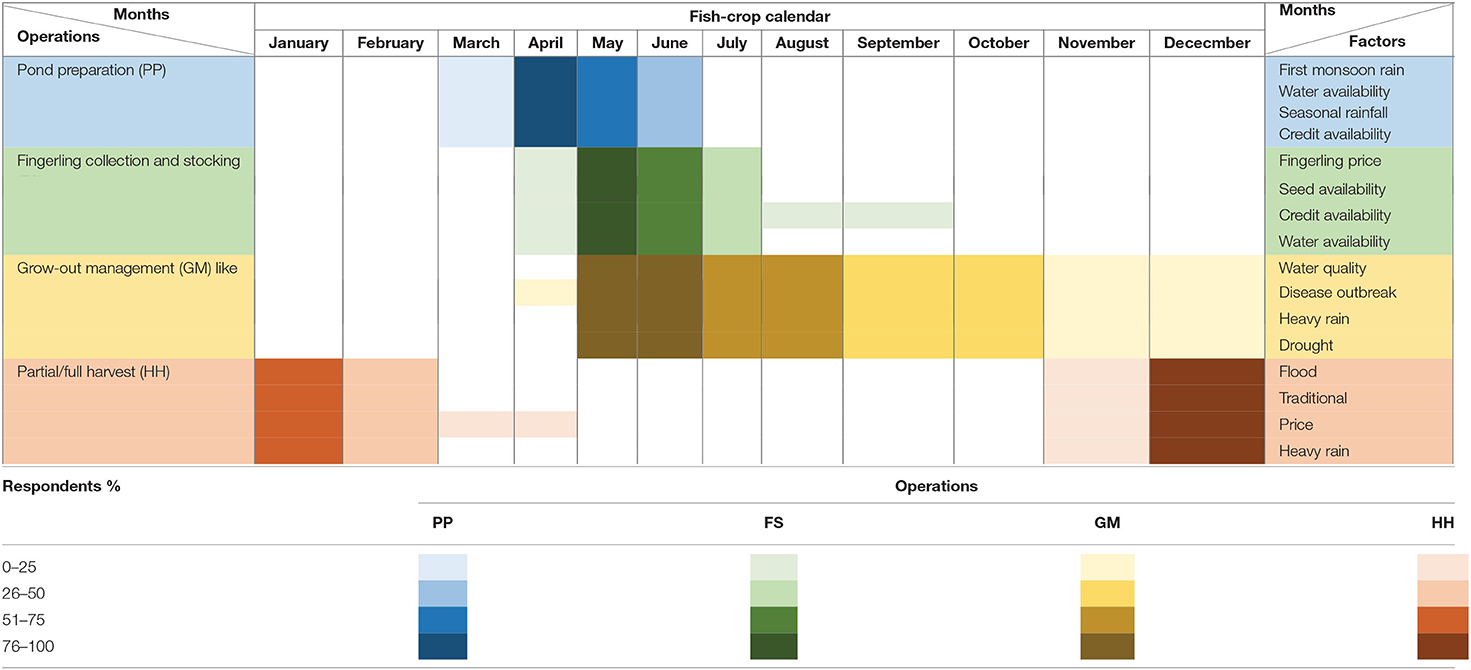
Table 2. Fish-crop calendar in study districts considering factors identified by farmers as contributing to operational and management decisions in the 2018 production season.
Knowledge of Fish Farmers on the Impacts of Climate Variability and Use of Climate Information for Aquaculture
Across the study districts, most of the fish farmers responded that they do not face considerable difficulties in fish production in relation to a particular climate variability (Figure 6). This result also indicates low awareness among farmers of indirect weather impacts on water quality and, hence, fish productivity. A similar result of farmers' low awareness of climate impacts on different coastal systems was reported by Hossain et al. (2018). However, those who responded positively identified high temperature, heavy rainfalls, and dry and cold spells as impacting climatic variables. Fish producers from Barisal (94%), Patuakhali (93%), and Khulna districts (50%) recognized high temperatures as the most challenging weather condition affecting their farms, while respondents from Sylhet suggested that heavy rainfalls and cold spells (both 33%, respectively) were most problematic. Respondents also identified five aquaculture management operations, namely pond preparation, fingerling collection and stocking, feeding, provision of inputs, and harvesting, which are sensitive to climate and weather variability (Figure 6). Conversely, information on the farmers' use of weather forecasts and climatic information suggested that 54–85% of the respondents do not currently use any climate information to assist in any aquaculture management operations (Figure 7). Those that use weather forecasts emphasized using them to prepare for heavy rainfalls (44–58%) and high temperatures (33–42%). The sources of this information are largely television and radio (Figure 7).

Figure 6. Fish-farmers' responses on difficulties encountered in aquaculture resulting from perceived climatic variability.
Responses of Fish Farmers on Climate-Sensitive Aquaculture Operations and Management Decisions
Feed management was recognized as the most sensitive part of aquaculture management conditioned by extreme weather events including heavy rainfalls (13–43%), dry spells (14–28%), high temperatures (30–44%), and cold spells (25–50%). Accordingly, farmers indicated that they respond to these conditions by halting fish feeding during heavy rain and by reducing feeding during high temperatures and both dry and cold spells (Figure 8). Respondents also distinguished fingerling collection and stocking as particularly sensitive to heavy rainfalls (38–47%), high temperatures (9–29%), and cold spells (13–27%). The primary action taken by farmers was to avoid collecting or stocking fingerlings during these conditions. Applying input materials (like fertilizer application, aqua-medicine use, managing irrigation, using aerator, etc.) is another sensitive part of aquaculture operations affected by all the identified climate variabilities. Respondents, therefore, prescribed decisions to stop using fertilizer and aqua-medicine during heavy rains, reduce fertilizer application, and manage irrigation during dry spells. Farmers also suggested that using a water aerator and adding water to adjust pond water level are common actions for responding to high temperatures. Conversely, no management conditions were identified for cold spells. Moreover, while pond preparation and harvesting were also identified as operations that are sensitive to temperature and rainfall variabilities, no management modifications were cited by farmers as common practices.
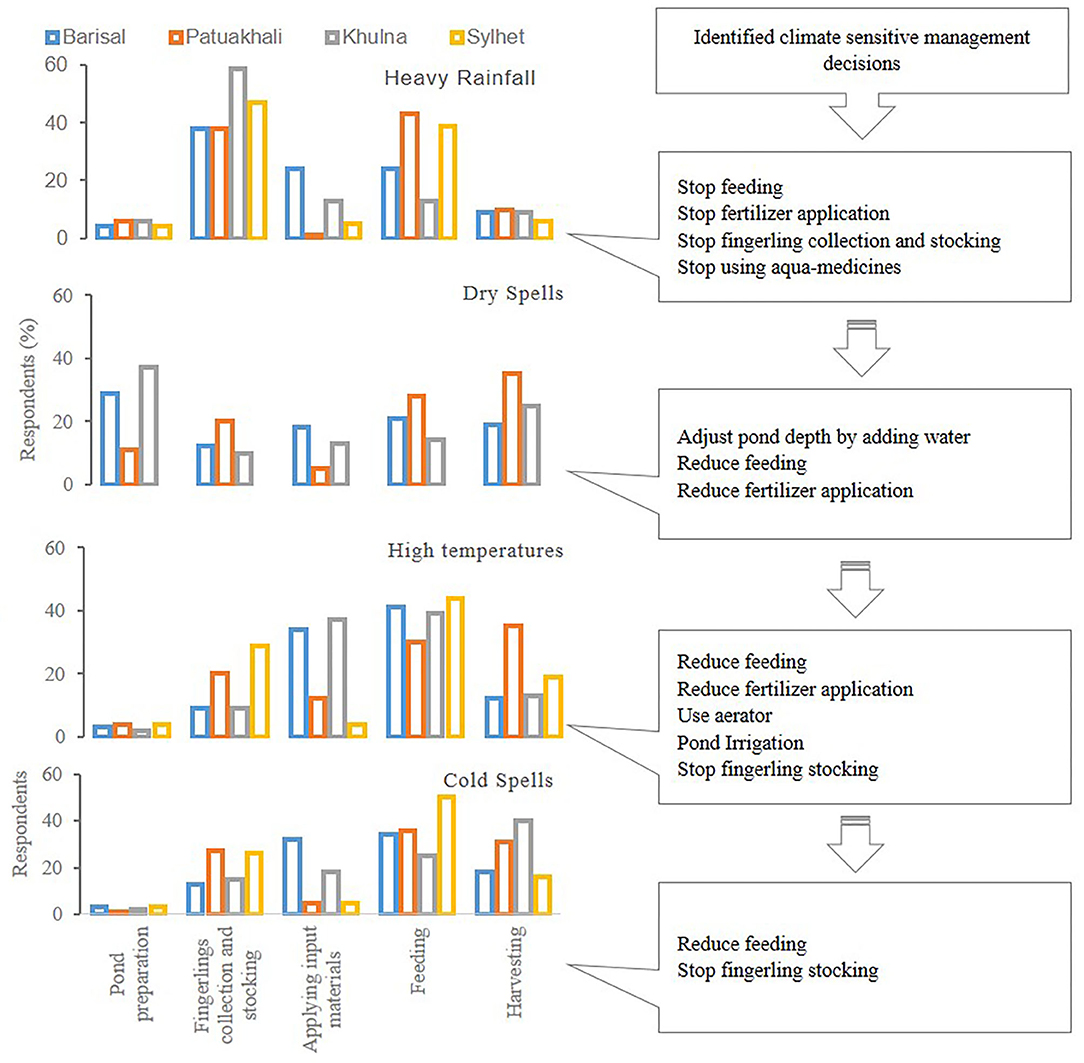
Figure 8. Climate sensitive aquaculture operations identified by farmers in relation to specific types of weather events and consequent management decisions.
Lead Times and Preferred Platforms for CIS
Across the study districts, most of the fish producers (41–49%) preferred having at least a 7-day lead time to use forecasts from a CIS, followed by 15 days (23–31%) and 5 days (14–22%). A few were interested in having a monthly (1–5%) or seasonal (6–8%) service (Figure 9A). Regarding the CIS platform, almost all the respondents (80–97%) preferred direct voice call as their first preference; however, the second preference was for TV (with up to 43% farmers) (Figure 9B).
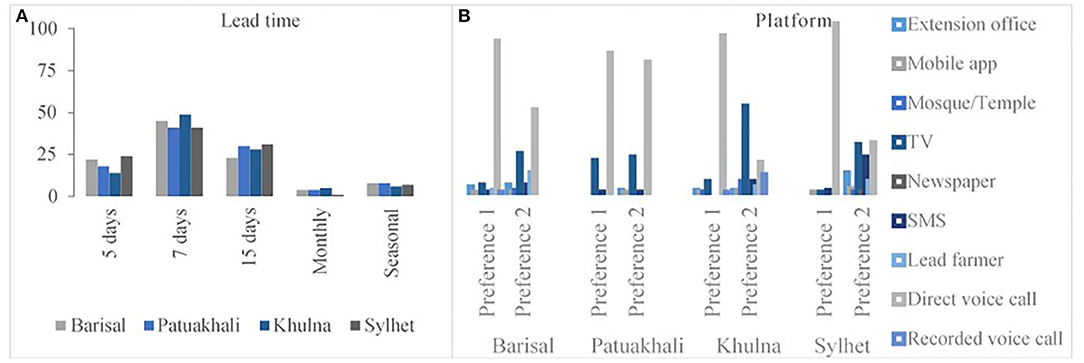
Figure 9. Preferred lead times to make decisions to change management practices and preferred platforms for climate information services delivery.
Key Informants' Responses on Climate-Sensitive Aquaculture Operations and Management Decisions
Similar to farmers, key informants identified high temperatures, cold and dry spells, and heavy rains as key weather phenomena that could affect different aquaculture operations, particularly water quality management, feeding, fingerling stocking, and harvesting (Table 3). According to key informants, high temperature plays a substantial role in water quality management, decreasing water pH (acidic/basic water), causing an imbalance in dissolved O2 (oxygen) and CO2 (carbon dioxide), and accelerating the generation of NH3 (ammonia) and H2S (hydrogen Sulfide) gas. These changes in pond water quality parameters can result in fish physiological stress, including reduced digestion capacity and food intake, both of which can reduce survival rate. To manage these challenges, the application of agricultural lime tends to be recommended. In addition, disinfectants, using a horra (a locally made tool for raking the pond bottom), zeolite, adding water, and supplying artificial O2 through aeration can help in maintaining water quality. Reduced feeding or stopping feeding in the afternoon and providing a vitamin C supplement in the morning are also prescribed for good fish growth during periods of high temperatures. In addition, respondents suggested that stocking fingerlings during high temperatures in the afternoon should be avoided to reduce shock. Conversely, they suggested that cold spells can increase the pH and cause imbalances in dissolved O2 and CO2, which can result in longer residence times at shallow depths and reduced food intake. In this situation, key informants suggested restricting the use of lime, implementing irrigation, providing O2 using either an aerator or oxygen-promoting aqua-medicines, reducing feeding, and if needed encouraging partial harvesting to reduce the density of the fish stock. During heavy rainfalls, the levels of dissolved O2 and pH can decline. Combined with a sudden drop in temperature, this can result in reduced food intake and potential mortality. To reduce these risks, aeration is beneficial for increasing the supply of dissolved O2 as well as applying lime after a heavy rainfall. An extremely heavy rain can result in pond flooding and also fish stocks escaping from enclosures. Key informants therefore suggested that farmers heighten pond banks and use nets to protect against losses. Conversely, dry spells were cited as conditions that reduce water availability because of evaporation from high temperatures, which can also affect feeding behavior and, under some circumstances, create ideal conditions for a disease outbreak. Respondents suggested that to manage these challenges, farmers can add water to ponds from ground water using pumps, or they can delay or reduce fingerling stocking. Farmers can also consider partially harvesting their ponds to reducing stock density while also adjusting feed supply.
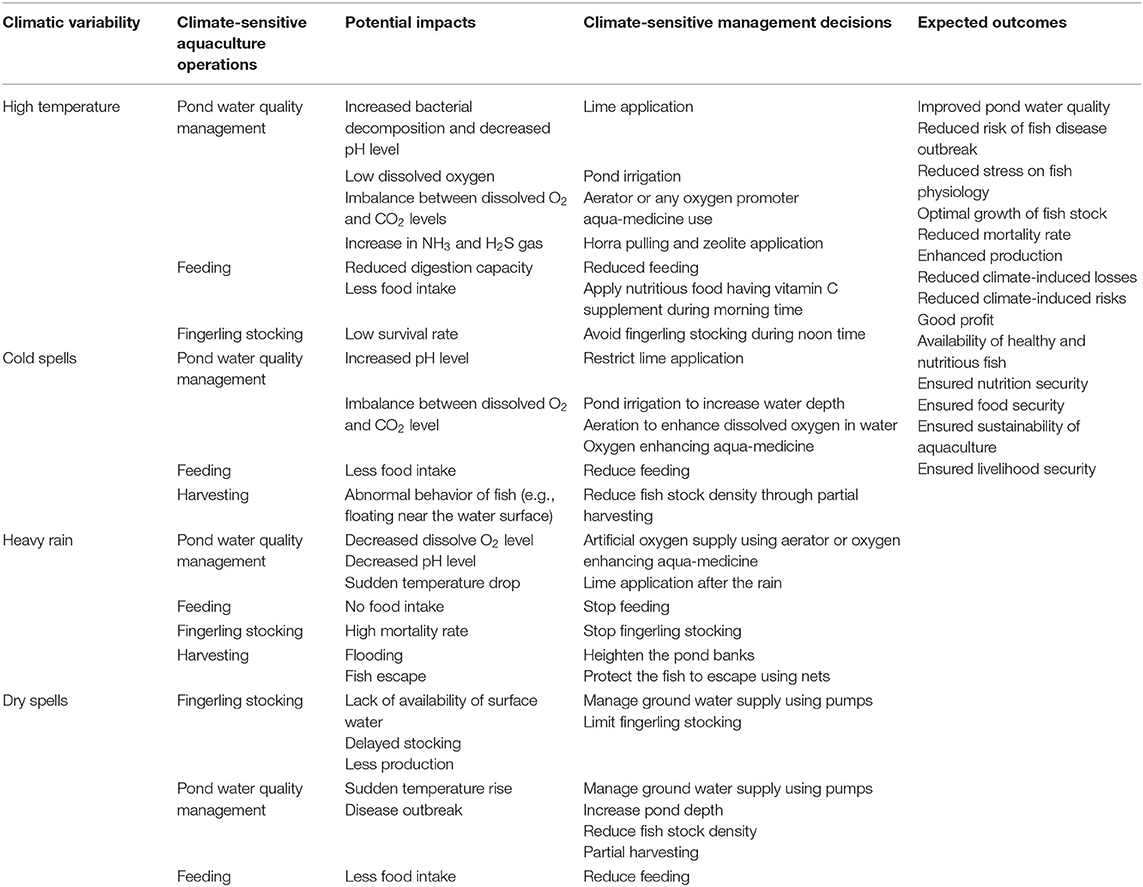
Table 3. Potential impacts of climate variability on aquaculture operations, potential management responses, and their intended effects, as described by the key informants.
Water Temperature and Rainfall Thresholds During the Grow-Out Phase for the Most Widely Cultured and Economically Important Fish Species in Bangladesh
Nile tilapia, rohu, freshwater prawn, and black tiger shrimp are the most widely cultured and economically important fish species for aquaculture in the study districts, as well as in Bangladesh as a whole (Table 4). Lower temperature (pond water) thresholds for tilapia and rohu were identified by key informants as between 20 and 22°C with standard deviation (SD) of 0.4 and 0.6, while the upper temperature threshold was between 32 and 30°C with SD of 0.5 and 0.7, respectively. For freshwater prawn and black tiger shrimp, similar upper and lower thresholds were identified as between 25 and 30°C with SD of 0.5 and 0.6. Conversely, upper temperature thresholds for tilapia and rohu were both identified as 31°C from the literature with SD of 2.9 and 2.4, while the lower limit was between 23 and 22°C with SD of 4.7 and 3.8, respectively. For freshwater prawn and black tiger shrimp, similar upper and lower thresholds were identified as between 26 and 33°C from the literature with SD of 4.1 and 1.8, correspondingly. Rainfall thresholds and the length of rainfall cessation provided by the meteorological experts from BMD were similar for all the species to identify dry spells as well as heavy and very heavy rainfalls (Table 4). When rain is <3 mm for 5 consecutive days during the monsoon season (June–September) and <1 mm for 5 consecutive days during the pre-monsoon (March–May) and post-monsoon (October–November) seasons, experts suggest that fish production could be negatively affected. Lastly, rainfall >44 mm/day was identified as heavy, while >88 mm/day was identified as the threshold for very heavy rain.
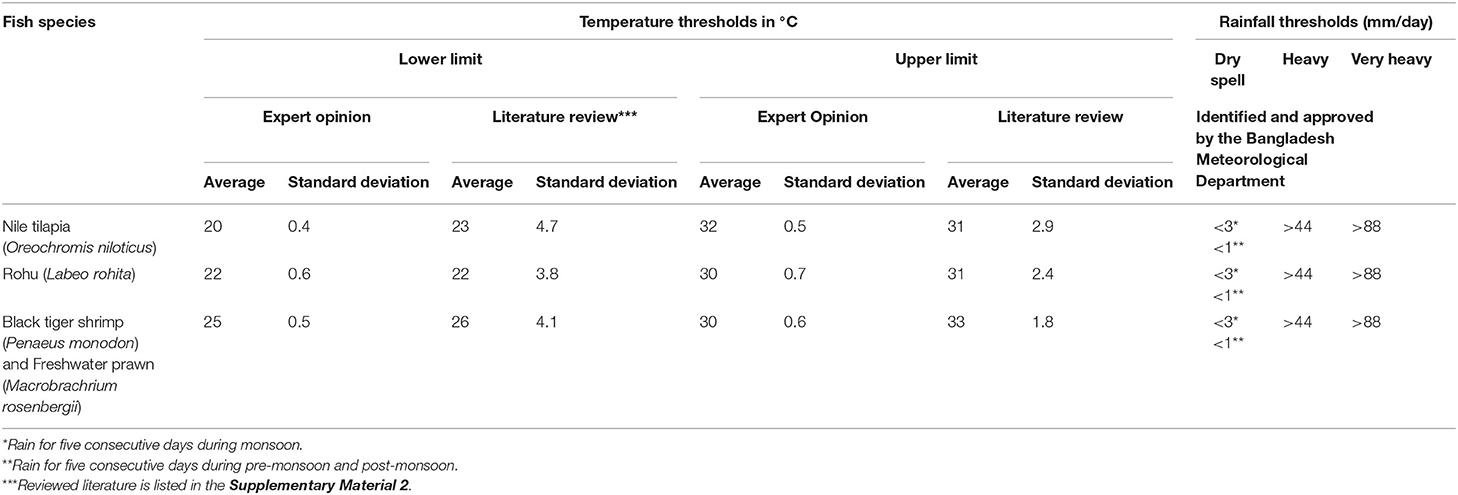
Table 4. Temperature and rainfall thresholds for the four mostly cultured and economically important fish species during the grow-out phase in Bangladesh.
Framework for Making Climate-Responsive Decisions Based on Temperature and Rainfall Thresholds
Based on the temperature and rainfall thresholds (with the lowest SD), we developed two different decision frameworks for the four most widely cultivated and economically important fish species in Bangladesh along with appropriate stock management responses (Figures 10, 11). As the intended CIS is to support smallholder fish farmers in managing their ponds and in aquaculture operations, a timeline is selected for the appropriate months of the grow-out phase of each species for both decision frameworks. For tilapia and rohu, the grow-out phase starts in May and ends in November, while for bagda (saltwater shrimp), it is from March to June, and for golda (freshwater prawn), from July to November. The conditions for the temperature decision framework are the maximum (Tmax) and minimum temperature (Tmin) thresholds of each species identified in Table 4. When the temperature goes above or below the critical limits of a particular species, the decision framework is triggered to the relevant decision points (such as water quality, feeding, and harvesting). It suggests modifications in management practices that can be presented to farmers as part of a CIS (Figure 10). On the other hand, the conditions for the rainfall decision framework include thresholds for very heavy rain, heavy rain, and dry spell. Thresholds do not differ by species during their grow-out phase and are, hence, applicable across the studied species. When rainfall forecasts exceed a threshold, the decision framework triggers the advice of appropriate management decisions for protective measures, feeding, harvesting, and water quality and availability (Figure 11).
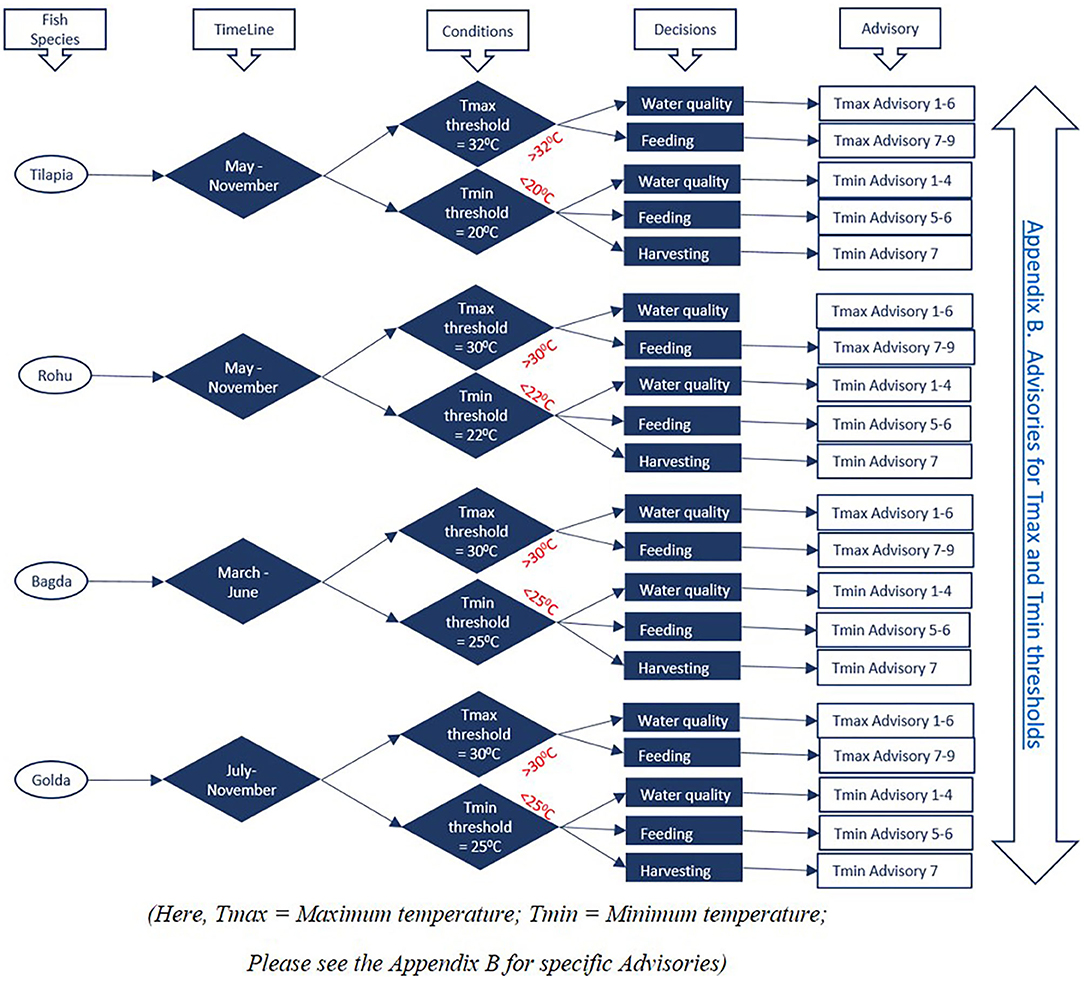
Figure 10. Decision framework based on temperature thresholds for four widely cultivated aquatic species in Bangladesh.
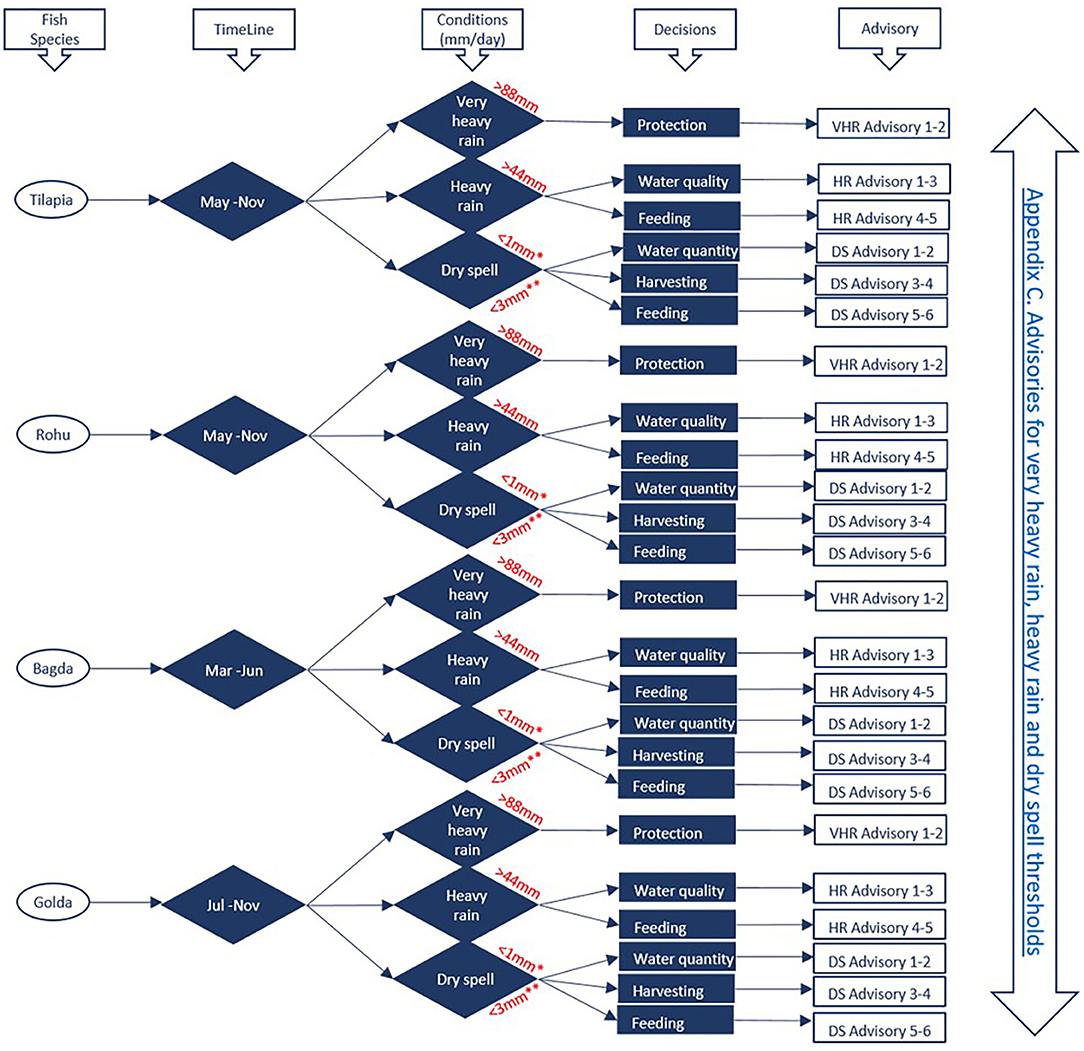
Figure 11. Decision framework based on rainfall thresholds for four widely cultivated aquatic species.
Discussion and Conclusions
As highlighted in the Introduction, no CIS system is currently available for aquaculture in South Asian countries that provides actionable species-specific advisories for aquatic farmers based on weather forecasts and thresholds. The reason, rooted in a global lack of extensive research or pilots on climate services for aquaculture, is the absence of a fish species-specific climatic threshold and climate-sensitive management information that can lead to effective advisories and, thus, reduce climate variability-induced risks. The current work has not only identified climatic thresholds and management decision points based on expert opinions and a literature review to create a decision framework, but it has also captured fish-farmers' perceptions on CIS for aquatic food systems. Considering social perceptions is key to success for building the resilience of a particular system (Hossain et al., 2018). The absence of formal aquaculture training for most of the farmers (Figure 3B) and a lack of knowledge on climate variability impacts on aquatic food systems (Figure 6) also indicate the need for capacity development of fish famers alongside raising awareness about weather impacts on aquatic food systems and, thus, productivity (Kumar et al., 2020b). The potential of such awareness-raising activities is highlighted by the higher number of informed respondents in Barisal and Patuakhali, which are hotspots of CIS research and development projects, such as agriculture climate services for mungbean (e.g., CSISA—https://csisa.org/csisa-bangladesh/). The higher frequency of climatic extreme events in the south-west coastal region is also responsible for this heightened awareness.
Besides, the low percentage of women respondents' participation (2–8%) during the fish-farmers' survey (Table 1) recognizes the need of empowering women in small-scale aquaculture decision-making in a substantive way. The low participation of rural women respondents may be due to their perception of fish farming as a full-time occupation of men (Halim and Ahmed, 2006), social restrictions, and the inability to access property, especially land that limits participation in economic activities like aquaculture (Kruijssen et al., 2018). Women's engagement to secondary or supplementary fish-farming activities, such as preparing feed, making and maintaining fishing nets, repairing and maintaining other fishing equipment, sorting of fingerlings, and post-harvest processing resulted only in restricted decision-making roles so far (Quddus et al., 2018).
Decision frameworks and threshold developments are conducted already for crop agriculture in Bangladesh (Krupnik et al., 2018), but the effort has not, so far, been recorded for aquaculture. Although only two fish and two crustacean species are currently included in the decision framework, the work is intended to spur additional research to include more species of economic importance. The choice of lead time and the systematic formulation of messages can make sure that available climate information is used to develop usable advisories (Singh et al., 2018). Most of the decisions are practical with a lead time of 3–5 days. A literature search of major aquaculture and climate service journals, as well as an internet search, found limited information upon which to develop species-specific decision frameworks for aquaculture, so a discussion with comparable studies is difficult. The decision framework presented here is modeled on the decision frameworks developed for crops under the Agvisely platform initiated by CIMMYT (https://www.agvisely.com); however, it is widely endorsed and developed for partner agencies of the Government of Bangladesh, such as the Bangladesh Agriculture Research Council and the Department of Agriculture Extension. The decision framework is expected to be integrated into the platform to offer the CIS for aquaculture, especially targeting extension agents connected to farmers. Farmers showed preference for voice calls (or recorded voice calls) for the climate service, but it can be prohibitively expensive to deploy voice calls to millions of farmers, unless there is willingness to pay for such services. This situation suggests a need for additional exploration on business models for climate services.
When integrated into the Agvisely climate service system, the decision framework will be able to trigger advisories for aquaculture farmers e.g. for pond water quality maintenance and feed management advice for tilapia once a weather forecast indicates that water temperatures are expected to breach 32°C in the next 5 days. Accordingly, fish farmers who have tilapia in their ponds at the grow-out phase can apply lime and use aerators to balance the pH and dissolved oxygen level. They can pump in additional water, perhaps using shallow or deep groundwater tube wells (Appendix B). It is to be noted that area-specific air and water temperature relationship will be integrated to operationalize this service. Similar Tmax advisories are applicable for the other three species, however, Tmax thresholds themselves differ (Figure 10). Conversely, temperatures below 20°C trigger Tmin advisories for water quality management, feeding, and harvesting modifications for tilapia. As a result, fish farmers can use advisory information to make decisions to turn on aerators, adjust pond water level, and apply lime to control pH. Generally, these advisories will be applicable for other species as well, depending on their Tmin thresholds. Similarly, if a rainfall exceeds 88 mm/day during the grow-out phase of the selected fish species, farmers are advised to consider protection measures for fish enclosures. Fish farmers can heighten pond banks and also use nets to prevent the fish from escaping (Appendix C). For heavy rain (>44 mm/day), the decision framework suggests options for pond water quality and feed management, including using aerators to increase dissolved O2 or applying lime to reduce water acidity. Farmers may also consider stopping feeding. Moreover, for dry spells (<1 mm/day during the pre-monsoon and post-monsoon seasons and <3 mm during the monsoon season for 5 consecutive days), fish farmers are advised to consider increasing the water supply to their ponds or to do a partial harvest along with reduced feeding.
Currently, the decision framework considers rainfall and temperature thresholds for tilapia and rohu, saltwater shrimp, and freshwater prawn species that trigger climate-sensitive management decisions along with specific advisories at different operations, such as fingerling collection and stocking, feeding, using input materials, and harvesting. The temperature thresholds trigger actions like aeration, irrigation, applying lime or zeolite, feeding, or harvesting decisions. Similarly, rainfall thresholds trigger advice on protection of fish and pond water quality and feed management, as well as pond watering decisions. Pond preparation was also identified as a major climate-sensitive decision, which is mainly affected by the onset of monsoon and not currently included in the decision framework as it is currently focused on the grow-out phase of the selected species. The next step for developing the climate advisory is to embed nationally endorsed weather forecasts from the Bangladesh Meteorological Department with the decision framework and deliver the advisories to farmers, likely through the Agvisely platform. Once integrated to the platform, an evaluation on the contribution of the CIS in preventing large-scale economic damages as well as enhancing productivity and overall resilience capacity of fish farmers will be carried out. It is expected that the service can create large economic benefits to farmers who are highly vulnerable to temperature and rainfall variability (Rao et al., 2019).
In addition to practical implications, the present study contributes to the emerging literature of climate services for aquatic food systems. For instance, this study identifies the sensitivity of different aquaculture operations to variability of temperature and rainfall. The work also extends the current understanding on using CIS for reducing short-term climate risks in aquaculture operations by recognizing five climate-sensitive management decision points and 26 potential advisories in line with variability of temperature or rainfall. Moreover, the comprehensive analysis based on three sources of information (fish-farmers' response, expert interviews, and literature review) of this study presents a method for developing decision trees based on specific climatic condition in relation to a particular fish species for the grow-out phase. This innovative decision support approach is to our knowledge the very first endeavor to develop species-specific temperature and rainfall thresholds based on CIS for South Asian aquaculture system to reduce climate risks.
The limitation of the decision framework currently is that it has included a limited number of species and identified only grow-out phase climatic thresholds and related advisory for the selected species. It could benefit from a horizontal expansion to a number of other finfish and shellfish species to cater to the needs of farmers cultivating these species and also vertical extension to other stages of growth like breeding and spawning to assist other value chain actors (i.e., hatchery managers). Secondly, the farmers demanded a lead time of 7–14 days; however, the advisories currently prescribed are limited to those that can be implemented within 5 days of lead time, which is highly reliable (appreciable skill in forecasting) in Bangladesh context (Kumar et al., 2020a). As the forecast skill in Bangladesh improves in the future (World Bank, 2018), additional actions with extended lead time can be included. However, fish-farmers' preference for 7–14 days of lead time is to secure resources for executing the management advisory, such as equipment, fertilizers or aqua-medicines, and labor. They need time to hire pumps (if not owned) for irrigating the ponds during a dry spell, arranging an aerator for maintaining water quality during high temperatures, and organizing labor and necessary implements for raising pond dikes or netting the pond during heavy rain. Also fish-farmers' preference for direct voice call may have a connection with low smartphone penetration in the rural areas than in the urban area of the country as well as with additional expenditure for continuous internet connection in using apps or other digital platforms (MoPTI, 2020). The current work reports a valuable first step in delivering aquaculture CIS to smallholder farmers that can provide clear actionable information in response to forecasted local climate conditions to manage climate risks and, thus, to reach the broader goals of ensuring livelihood, food, and nutrition security. The work mapped climate-sensitive decisions in aquaculture and developed advisories specific to growth stage and also timelines for four major species using multiple sources of information. If the efforts to develop a CIS using the specified decision framework become fruitful, it can offer significant positive benefits and act as a template for similar services in other countries. The expected outcomes are improved pond water quality, reduced disease outbreak, reduced stress on fish physiology, good growth of fish stock, reduced fish mortality rate, increased production, and reduced climate-induced loss, all of which ensure better profits for farmers and provide food and nutrition security to the population. It is expected that the decision framework will continue growing with more climate-sensitive decision points and additional fish species, and that it will become a mature climate service tool over time. Given the production of 2.4 million metric tons of fish in 2017–2018 from closed aquaculture systems in Bangladesh, an increase in production by 1% can provide 24,000 tons of fish that can cater to the yearly protein needs of one million people (at a recommended allowance of 60 g/day). This indicates the potential value creation and contribution to food and nutritional security by operationalizing an aquaculture climate service. The increased availability of fish also disproportionately benefits poorer communities, given their higher price elasticity of fish consumption. Given the challenges in sustaining capture fisheries, there is an increasing dependence on aquaculture for Bangladesh's fish supply. Therefore, ensuring climate smartness, especially higher production and resilience in aquaculture systems, is of critical value to overall food system resilience and sustainability. The provision of climate services can act as a risk reduction intervention, and the reduced risk levels act as a mechanism to increase investments in aquaculture by small farmers. The creation of the reported decision framework is a crucial step in realizing this promising opportunity.
Data Availability Statement
The original contributions presented in the study are included in the article/Supplementary Material, further inquiries can be directed to the corresponding author/s.
Ethics Statement
Ethical review and approval was not required for this study with human participants, in accordance with the local legislation and institutional requirements.
Author Contributions
PH led the development of the paper, overall framing, data collection, analysis, and writing the manuscript. TA-B contributed in writing the discussion and conclusion section. TK, MB, EM, and MP critically reviewed the manuscript which went through multiple revisions by PR and TA-B. Finally, PR coordinated and integrated the co-authors input for finalizing the manuscript. All authors contributed to the article and approved the submitted version.
Funding
This research was supported by the CGIAR research program on Climate Change Agriculture and Food Security (CCAFS; https://ccafs.cgiar.org/)-funded project entitled Capacitating Farmers and Fishers to manage climate risks in South Asia (CaFFSA), by ACToday-the first of Columbia University's World Projects, and by the USAID and Bill and Melinda Gates Foundation (BMGF)-supported Cereal Systems Initiative for South Asia (CSISA). USAID, BMGF, and CCAFS do not necessarily endorse the findings of this paper, and the results of this paper shall not be used for advertising purposes.
Conflict of Interest
The authors declare that the research was conducted in the absence of any commercial or financial relationships that could be construed as a potential conflict of interest.
Supplementary Material
The Supplementary Material for this article can be found online at: https://www.frontiersin.org/articles/10.3389/fsufs.2021.677069/full#supplementary-material
References
Barange, M., Bahri, T., Beveridge, M. C., Cochrane, K. L., Funge-Smith, S., and Poulain, F. (2018). Impacts of Climate Change on Fisheries and Aquaculture. Rome: United Nations' Food and Agriculture Organization.
Belton, B., van Asseldonk, I. J. M., and Thilsted, S. H. (2014). Faltering fisheries and ascendant aquaculture: implications for food and nutrition security in Bangladesh. Food Policy 44, 77–87. doi: 10.1016/j.foodpol.2013.11.003
BFTI (2016). Bangladesh Foreign Trade Institute, Study on Sector Based Need Assessment of Business Promotion Council-Fisheries Products. Dhaka: Kawran Bazar.
Bogard, J. R., Thilsted, S. H., Marks, G. C., Wahab, M. A., Hossain, M. A., Jakobsen, J., et al. (2015). Nutrient composition of important fish species in Bangladesh and potential contribution to recommended nutrient intakes. J. Food Compos. Anal. 42, 120–133. doi: 10.1016/j.jfca.2015.03.002
Cheng, C. P., Lin, H. I., Wang, S., Dean Liu, P. T., and Camyale Chao, K. Y. (2020). CIS in Asia Pacific: emerging trends and prospects. Bull. Am. Meteorol. Soc. 101, E1568–E1571. doi: 10.1175/BAMS-D-20-0093.1
Dayamba, D. S., Ky-Dembele, C., Bayala, J., Dorward, P., Clarkson, G., Sanogo, D., et al. (2018). Assessment of the use of Participatory Integrated CIS for Agriculture (PICSA) approach by farmers to manage climate risk in Mali and Senegal. CIS 12, 27–35. doi: 10.1016/j.cliser.2018.07.003
Ghose, B. (2014). Fisheries and aquaculture in Bangladesh: challenges and opportunities. Ann. Aquacult. Res. 1, 1–5.
GoB (2008). Damage, Loss, and Needs Assessment for Disaster Recovery and Reconstruction–Assessment Report. Dhaka: Government of Bangladesh (GoB).
Halim, S., and Ahmed, M. K. (2006). Women in fisheries in Bangladesh: level of involvement and scope for enhancement, in Global Symposium on Gender and Fisheries (Penang: WorldFish Center), 159–168.
Hansen, J. W., Vaughan, C., Kagabo, D. M., Dinku, T., Carr, E. R., Körner, J., et al. (2019). Climate services can support african farmers' context-specific adaptation needs at scale. Front. Sustain. Food Syst. 3:21. doi: 10.3389/fsufs.2019.00021
Hossain, P. R. (2018). Impacts of Climate Change on Coastal Ecosystems of Bangladesh. Wageningen: Wageningen University.
Hossain, P. R., Ludwig, F., and Leemans, R. (2018). Adaptation pathways to cope with salinization in south-west coastal region of Bangladesh. Ecol. Soc. 23:27. doi: 10.5751/ES-10215-230327
Howell, C. R., Su, W., Nassel, A. F., Agne, A. A., and Cherrington, A. L. (2020). Area based stratified random sampling using geospatial technology in a community-based survey. BMC Public Health 20:1678. doi: 10.1186/s12889-020-09793-0
Kalikoski, D. C., Jentoft, S., Charles, A., Salazar, D., Herrera, K. C., Béné, C., et al. (2018). Understanding the impacts of climate change for fisheries and aquaculture: applying a poverty lens, in Impacts of Climate Change on Fisheries and Aquaculture, eds M. Barange, T. Bahri, M. C. M. Beveridge, K. L. Cochrane, S. Funge-Smith, and F. Poulain (Rome: FAO), 19–41.
Khatun, M. A., Rashid, M. B., and Hygen, H. O. (2016). Climate of Bangladesh. Met Report by Norwegian Meteorological Institute and Bangladesh Meteorological Department. No. 08/2016, ISSN 2387-4201.
Kruijssen, F., McDougall, C. L., and van Asseldonk, I. J. (2018). Gender and aquaculture value chains: a review of key issues and implications for research. Aquaculture 493, 328–337. doi: 10.1016/j.aquaculture.2017.12.038
Krupnik, T. J., Hussain, S. G., Montes, C., Schulthess, U., Siddiquee, A. A., Rahman, M. S., et al. (2018). CIS for Resilient Development in South Asia. End of Project Report, September 2016–December 2019. Dhaka: International Maize and Wheat Improvement Center (CIMMYT).
Kumar, U., Werners, S., Paparrizos, S., Datta, D. K., and Ludwig, F. (2020a). Hydroclimatic information needs of smallholder farmers in the lower Bengal delta, Bangladesh. Atmosphere 11:1009. doi: 10.3390/atmos11091009
Kumar, U., Werners, S., Roy, S., Ashraf, S., Hoang, L. P., Kumar Datta, D., et al. (2020b). Role of information in farmers' response to weather and water related stresses in the Lower Bengal Delta, Bangladesh. Sustainability 12:6598. doi: 10.3390/su12166598
MoF (2020). Yearjournal of Fisheries Statistics of Bangladesh 2018–19. Dhaka: Ministry of Fisheries and Livestock.
MoPTI (2020). Bangladesh National ICT Household Survey Report: Overview of Main Results 2018–2019. Jointly conducted by Alliance for Affordable Internet (A4AI) and Access to Information (A2I) programme. ICT Division–Ministry of Posts, Telecommunications and Information Technology (MoPTI).
Quddus, A., Jui, N. Z., Rahman, K. M. M., and Rahman, M. (2018). Gender role in pond fish culture in terms of decision making and nutrition security. Bangladesh J. Agric. Econ. 38, 55–71. doi: 10.22004/ag.econ.278762
Rao, K. P. C., Dakshina Murthy, K., Dhulipala, R., Bhagyashree, S. D., Das Gupta, M., Sreepada, S., et al. (2019). Delivering Climate Risk Information to Farmers at Scale: The Intelligent Agricultural Systems Advisory Tool (ISAT). Wageningen: CGIAR.
Roy, D., Al Masud, A., Saha, P. K., Kutubuddin, M. M., and Islam, M. M. (2019). Water quality, growth and production performance of stinging catfish, Heteropneustes fossilis (Bloch) in cemented tanks with two different stocking densities. Bangladesh J. Zool. 47, 107–119. doi: 10.3329/bjz.v47i1.42026
Saha, M. (2020). Floods in Gopalganj: 5,500 Fish-Farmers Suffer 50C Loss. A Report From Dhaka Tribune. Available online at: https://www.dhakatribune.com/bangladesh/nation/2020/08/18/floods-in-gopalganj-5-500-fish-farmers-incur-about-tk50cr-loss (accessed April 12, 2021).
Sarder, M. R. I. (2020). Potential of fish gamete cryopreservation in conservation programs in Bangladesh, in Cryopreservation of Fish Gametes, eds J. Betsy and S. Kumar (Singapore: Springer), 337–344. doi: 10.1007/978-981-15-4025-7_14
Shamsuzzaman, M. M., Islam, M. M., Tania, N. J., Al-Mamun, M. A., Barman, P. P., and Xu, X. (2017). Fisheries resources of Bangladesh: present status and future direction. Aquacult. Fish. 2, 145–156. doi: 10.1016/j.aaf.2017.03.006
Shelton, C. (2014). Climate Change Adaptation in Fisheries and Aquaculture: Compilation of Initial Examples. Rome: FAO Fisheries and Aquaculture Circular.
Singh, C., Daron, J., Bazaz, A., Ziervogel, G., Spear, D., Krishnaswamy, J., et al. (2018). The utility of weather and climate information for adaptation decision- making: current uses and future prospects in Africa and India. Clim. Dev. 10, 389–405. doi: 10.1080/17565529.2017.1318744
Vaughan, C., Hansen, J., Roudier, P., Watkiss, P., and Carr, E. (2019). Evaluating agricultural weather and CIS in Africa: evidence, methods, and a learning agenda. Wiley Interdiscipl. Rev. Clim. Change 10:e586. doi: 10.1002/wcc.586
World Bank (2018). Improving Lead Time for Tropical Cyclone Forecasting: Review of Operational Practices and Implications for Bangladesh. Available online at: https://elibrary.worldbank.org/doi/abs/10.1596/29825
Keywords: climate, variability, risks, aquaculture, services, threshold, fish-farmers
Citation: Hossain PR, Amjath-Babu TS, Krupnik TJ, Braun M, Mohammed EY and Phillips M (2021) Developing Climate Information Services for Aquaculture in Bangladesh: A Decision Framework for Managing Temperature and Rainfall Variability-Induced Risks. Front. Sustain. Food Syst. 5:677069. doi: 10.3389/fsufs.2021.677069
Received: 07 March 2021; Accepted: 23 April 2021;
Published: 07 June 2021.
Edited by:
Emmanuel Donkor, Humboldt University of Berlin, GermanyReviewed by:
Enoch Bessah, Kwame Nkrumah University of Science and Technology, GhanaHenry Jordaan, University of the Free State, South Africa
Dennis Olumeh, Humboldt University of Berlin, Germany
Copyright © 2021 Hossain, Amjath-Babu, Krupnik, Braun, Mohammed and Phillips. This is an open-access article distributed under the terms of the Creative Commons Attribution License (CC BY). The use, distribution or reproduction in other forums is permitted, provided the original author(s) and the copyright owner(s) are credited and that the original publication in this journal is cited, in accordance with accepted academic practice. No use, distribution or reproduction is permitted which does not comply with these terms.
*Correspondence: Peerzadi Rumana Hossain, p.hossain@cgiar.org
 Peerzadi Rumana Hossain
Peerzadi Rumana Hossain